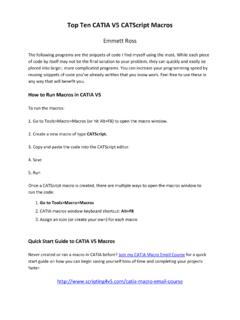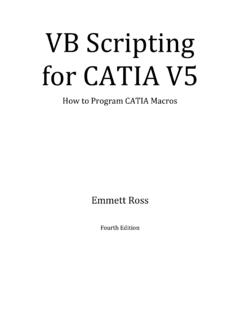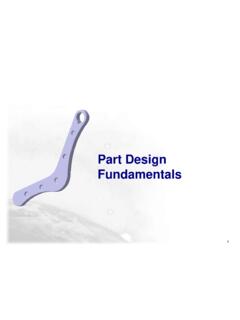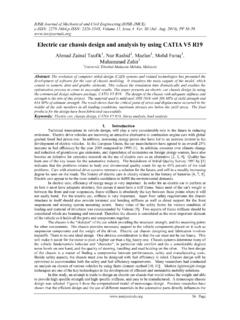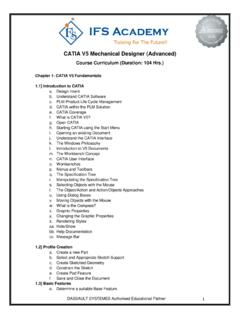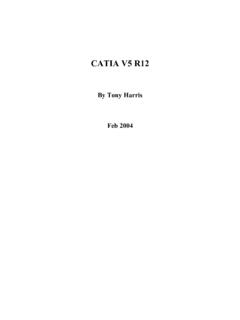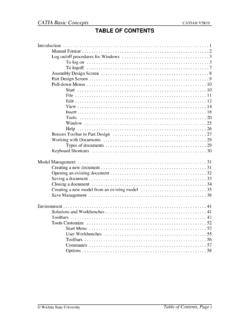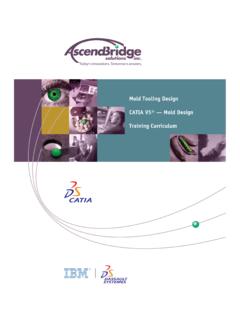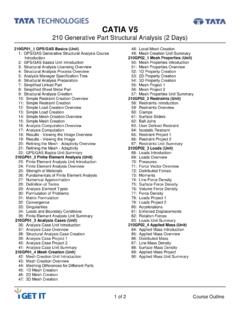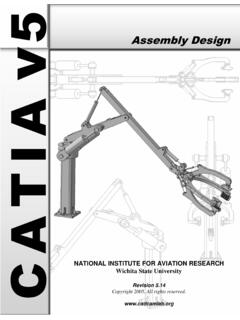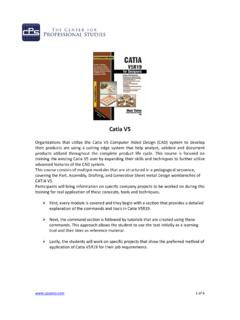Transcription of VB Scripting for CATIA V5: Email Course by Emmett Ross ...
1 VB Scripting for CATIA V5: Email Course by Emmett Ross Lesson #1 - introduction to CATIA programming Are you tired of repeating those same time-consuming CATIA processes over and over? Worn out by thousands of mouse clicks? Don t you wish there were a better way to do things? What if you could rid yourself those hundreds of headaches by teaching yourself how to program macros while impressing your bosses and co-workers in the process? VB Scripting for CATIA V5 is the ultimate guide to teach you how to write macros for CATIA V5! Through a series of example codes and tutorials you ll learn how to unleash the full power and potential of CATIA V5.
2 No programming experience is required! There are many CAD engineers, designers, and technicians who want to write macros but simply don't have the time or money to go to an expensive third party training class. This text will cover the core items to help teach beginners important concepts needed to create custom CATIA macros. More importantly, you ll learn how to solve problems and what to do when you get stuck. Once you begin to see the patterns you ll be flying along on your own in no time. What is a Macro and why do we use them? A macro is a series of functions written in a programming language that is grouped in a single command to perform the requested task automatically.
3 If you perform a task repeatedly you can take advantage of a macro to automate the task. Why do manual labor when you can simply press a button instead? Macros are used to save time and reduce the possibility of human error by automating repetitive processes. Other advantages include standardization, improving efficiency, expanding CATIA 's capabilities, and streamlining procedures. Macros use programming but you don't need to be a programmer or have programming knowledge to use them (though it certainly does help). The application of automation in the design process is virtually unlimited.
4 Some real world examples of CATIA automation at work: Batch script for the conversion of CATD rawing files to PDF Batch script to convert CATP arts to STP files Import of points from an Excel spreadsheet to a 3D CAD model Export of data from CATIA model to a bill of material spreadsheet Automatic geometry creation from selection Automatic drawing creation Custom functions And so on and so on. The possibilities are nearly limitless. Terms and Definitions The following is a list of terms and their definitions which will be used frequently throughout this text. It is recommended that you become familiar with them if you aren t already.
5 A quick reference of acronyms is listed in the appendices of this book as well. Integrated Development Environment (IDE) is a computer application to help programmers develop software and typically consists of a source code editor, debugger, build automation tools, object browser, and a compiler or interpreter. IDEs typically have built-in syntax checkers, color coded schemes, and automatic code completion. The Visual Basic Editor in CATIA and Excel is an example of an IDE. Graphical User Interface (GUI) is a way for humans to interact with computers with graphical elements such as windows, menus, toolbars, icons, etc.
6 Which can be manipulated by a mouse. The VBA editor is a perfect example. Command Line Interface (CLI) is a way for humans to interact with computers through text only and is accessed solely by a keyboard. The most common example is MS-DOS. Component Application Architecture (CAA, CAA V5, or CNext) is the Application programming Interface (API) or technological infrastructure designed to support Dassault Syst mes products. It is an open development platform enabling programmers to develop and integrate their own applications for CATIA or other Dassault Syst mes products.
7 CAA V5 is faster and more powerful than VB. It provides access to interfaces not available to Visual Basic but is harder to learn. C++ is the primary language. A single source code is used for both Windows and UNIX. CAA Rapid Application Development Environment (RADE) provides a workbench to develop PLM applications using the component object model object oriented programming . CAA is beyond the current scope of this text. Object Oriented programming (OOP) is where programmers define not only the data type of a data structure, but also the types of operations, or functions, that can be applied to the data structure.
8 An object in software is a structure that consists of data fields and subroutines or functions. Everything in CATIA is an object; the data fields are called Properties and the subroutines and functions are called Methods. All the data and functions have owners which are the objects to which they belong. A thorough understanding of OOP is critical to your success in macro programming . More on this later. Component Object Model (COM) is a Microsoft technology that enables sharing of binary code across different applications and languages. CATIA V5 is COM enabled software. Codes for COM objects or components can be called, initiated, or created at any time because they are stored in DLL files and registered in the Windows registry.
9 If CATIA calls Excel, CATIA is then the client and Excel is the server, or the one that provides services to the client. VB talks to CATIA through Dynamic Linked Libraries (DLL). DLLs are compiled files that contain all of the functions that make CATIA V5 perform an action. For example, when you select the point function in CATIA , the program calls a function inside one of the dll files that performs the action of creating a point in the V5 database. These files are both compiled and encrypted (or mangled ) and are located in the UNLOAD directory for CATIA V5 (C:\Program Files\Dassault Systemes\B20\intel_1\code\bin).
10 Encryption is a method by which software companies can ensure that others cannot access the function inside the dlls. You cannot directly call the dlls from outside applications, therefore extra programming needs to be done to allow the dlls to be exposed to Windows and the COM object model. This is done via Type Library Files. Type Library Files (TLB) are files necessary for exposing functions to Windows by acting as maps which point to the functions inside of the dll files that make CATIA V5 work. The TLB files are also located in the UNLOAD directory for V5.

